Experimental Highlights - 2016
March
Testing NIF’s Dual-Axis Imager
Two x-ray images of a NIF experiment are better than one.
That’s the theory behind the development of a new dual-axis x-ray camera designed to acquire two high-resolution images of NIF implosions. The camera, the Advanced Radiographic Capability (ARC) X-ray Imaging System, or AXIS, is capable of recording two Compton radiographs during a single NIF shot.
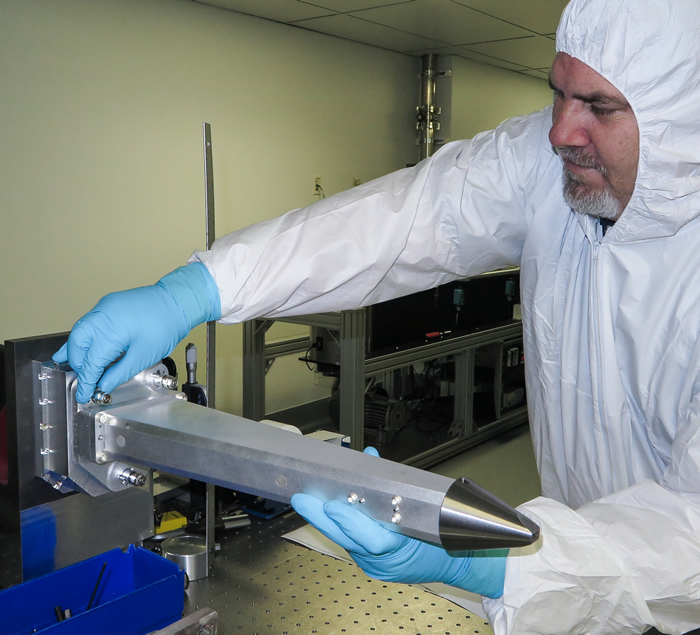 Technician Tim Cunningham prepares the ARC X-ray Imaging System (AXIS) diagnostic snout for its first data shot on March 1. Credit: James Pryatel
Technician Tim Cunningham prepares the ARC X-ray Imaging System (AXIS) diagnostic snout for its first data shot on March 1. Credit: James Pryatel Compton radiography is an important diagnostic for inertial confinement fusion (ICF), as it provides a means to measure the density and asymmetries of the deuterium-tritium (DT) fuel in an ICF capsule near the time of peak compression. It will be a key diagnostic component of experiments using ARC, the NIF petawatt-class laser with peak power exceeding a quadrillion (1015) watts. ARC will produce brighter, more penetrating, higher-energy x rays than can be obtained with conventional radiographic techniques to image experiments driven by the main NIF laser.
NIF researchers conducted the first two tests of the new AXIS detector in combination with ARC-generated x-ray sources on March 1 and 2. In the first experiment, four 30-picosecond-long, 850-joules-per-beam ARC pulses irradiated two gold micro-wires to generate two short-pulse hard x-ray backlighting sources.
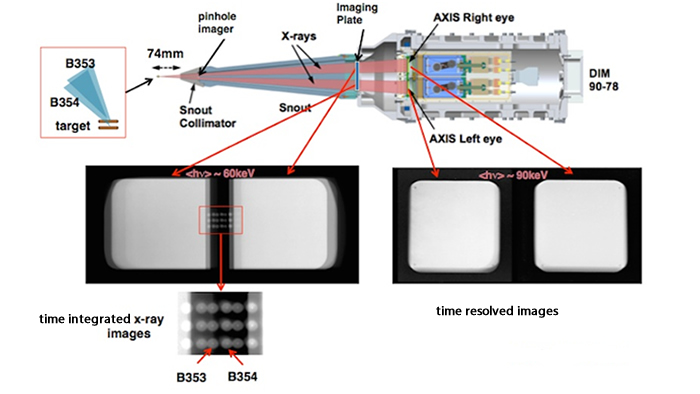 In the March 1 experiment, AXIS detected very good x-ray signals from both backlighters using pulse durations and photon energies relevant to Compton radiography. Credit: Riccardo Tommasini and the AXIS and ARC teams.
In the March 1 experiment, AXIS detected very good x-ray signals from both backlighters using pulse durations and photon energies relevant to Compton radiography. Credit: Riccardo Tommasini and the AXIS and ARC teams. In the second experiment, ARC irradiated gold wires to backlight a 200-micron-diameter tungsten-carbide sphere. An excellent radiograph of the test object was produced.
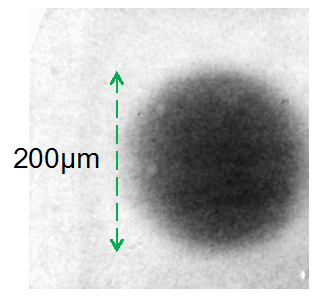 AXIS recorded this radiograph of a 200-micron-diameter tungsten-carbide sphere on March 2.
AXIS recorded this radiograph of a 200-micron-diameter tungsten-carbide sphere on March 2. Meeting the scientific requirements of the Compton radiography platform requires that two point-projection radiographs be obtained on a single experiment, allowing study of the implosion dynamics around the time when the fuel is densest and guaranteeing that a radiograph is always obtained when there is uncertainty in the timing of peak compression.
AXIS is a framing camera designed specifically for NIF Compton radiography with ARC. It will record two radiographs with an equivalent line of sight, a 300-micron-square field of view at the capsule, and 128× magnification. AXIS will achieve ≥20 signal to noise for neutron yields up to 4×1014, allowing fuel areal density (ρR) to be measured with an accuracy of 5 percent. This is achieved by minimizing noise onto the detector through a combination of shielding and time gating.
AXIS was developed primarily to meet the need for significantly improved detection quantum efficiency, or DQE, at high x-ray energies. The ARC laser will produce x-ray backlighter sources ranging from 50,000 to 200,000 electron volts, and AXIS will be capable of recording these high-energy x-rays with a DQE several times greater than other NIF x-ray cameras. AXIS also will provide a much larger field of view of the imploded capsule. AXIS’ larger signal-to-noise ratio will allow the density and distribution of the compressed DT fuel to be measured with significantly greater accuracy as ICF experiments are tuned for ignition.
The AXIS team members are Gareth Hall, Nobuhiko Izumi, Riccardo Tommasini, Joe Holder, Dana Hargrove, Perry Bell, Dave Bradley, Nino Landen, Alexander Lumbard, Jason Cruz, Ken Piston, Arthur Carpenter, Nathan Palmer, Brian Felker, Vern Rekow, Fred Allen, Rich Zacharias, Rick Montesanti, Bradford Petre, Maryum Ahmed, Tom Lee, Carl Hardy, and Cal Smith.
Targeting Extreme Physics
As the pursuit of fusion ignition continues on NIF, LLNL researchers also are conducting increasingly challenging experiments that peer more and more deeply into the behavior of materials under extreme temperatures and pressures. And a key to the success of these experiments is the development and refinement of intricate, precisely fabricated targets that meet the researchers’ needs.
NIF’s millimeter-sized targets are used in inertial confinement fusion (ICF), high energy density (HED), and Discovery Science experiments that often are possible only under the extreme conditions that exist in the NIF Target Chamber. While some target designs can be used more than once, others must continually be revamped in response to experimental results and the requirements of NIF’s increasingly sophisticated diagnostics.
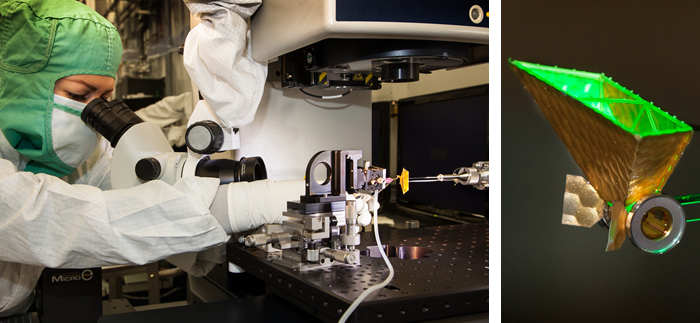 Target Fabrication technician Kristie Segraves attaches a light shield during the final steps in fabricating a “GigaBar3” target in the NIF Target Fabrication Facility. The target was used in an experiment designed to measure in-flight electron density, temperature, and ionization balance in a target capsule exposed to pressures approaching or exceeding one gigabar (one billion atmospheres)—conditions which currently can be achieved only in implosion experiments at NIF. At right is a close-up of the GigaBar3 target showing the large backlighter cone; the shield protecting the hohlraum’s laser entrance hole from light from the backlighter is on the lower left. Credit: James Pryatel
Target Fabrication technician Kristie Segraves attaches a light shield during the final steps in fabricating a “GigaBar3” target in the NIF Target Fabrication Facility. The target was used in an experiment designed to measure in-flight electron density, temperature, and ionization balance in a target capsule exposed to pressures approaching or exceeding one gigabar (one billion atmospheres)—conditions which currently can be achieved only in implosion experiments at NIF. At right is a close-up of the GigaBar3 target showing the large backlighter cone; the shield protecting the hohlraum’s laser entrance hole from light from the backlighter is on the lower left. Credit: James Pryatel “All of these targets are designed to re-create the physics regimes our investigators require to probe matter in extreme environments,” said NIF & Photon Science Principal Associate Director Jeff Wisoff in a commentary in the January/February 2016 issue of Science & Technology Review. “Indeed, NIF’s suite of capabilities, including diagnostics, laser attributes, staff expertise, as well as targets, have evolved in response to the extreme physics necessary for our investigators’ research.”
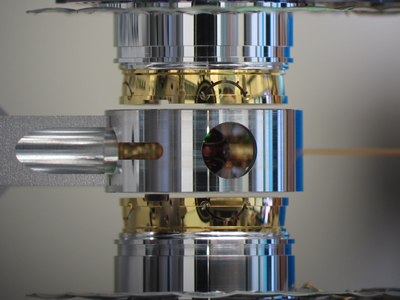 Rugby-shaped hohlraums are being tested to determine if they can improve drive symmetry control on the NIF target capsule.
Rugby-shaped hohlraums are being tested to determine if they can improve drive symmetry control on the NIF target capsule. Targets designed for ICF experiments, for example, include a variety of hohlraum shapes, sizes, and linings as well as target capsule materials ranging from plastic to beryllium and high-density carbon, or diamond. The targets provide information on such things as shock timing, capsule implosion shape, implosion velocity, and the extent to which the colder deuterium-tritium fuel in the capsule mixes with the “hot spot” in the core. Researchers also are investigating several different methods of suspending the target capsule in the center of the hohlraum, in an effort to reduce implosion instabilities caused by the ultrathin polymer “tents” currently used.
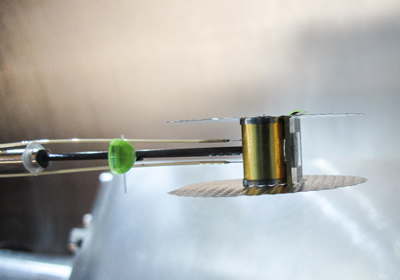 A target consisting of a step target of iron glued onto a step target of copper used in a NIF Discovery Science experiment to measure the equation of state of iron under ramp, or gradual, compression to a peak pressure of 14 Mbar (14 million times Earth’s atmospheric pressure). The equation of state characterizes the state of matter of a material under a given set of physical conditions.
A target consisting of a step target of iron glued onto a step target of copper used in a NIF Discovery Science experiment to measure the equation of state of iron under ramp, or gradual, compression to a peak pressure of 14 Mbar (14 million times Earth’s atmospheric pressure). The equation of state characterizes the state of matter of a material under a given set of physical conditions. HED material strength experiments measure the strength of a variety of materials at pressures never previously achieved in a laboratory. By “ramping,” or gradually increasing the pressure on the sample, the experiments can avoid forming a shock wave that increases the sample’s temperature and thus limits the types of data that can be obtained.
Among NIF’s most exotic targets are the TriStar and QuadStar targets—three or four hohlraums joined together for Discovery Science experiments designed to study the star-formation process in molecular hydrogen clouds, such as the famous “Pillars of Creation” in the Eagle Nebula (see “Unlocking the Secrets of Star Creation”).
In the most recent Eagle experiment, the NIF lasers drove four hohlraums one after another, from times of 0 to 15 nanoseconds, 15 to 30 ns, 30 to 45 ns, and 45 to 60 ns,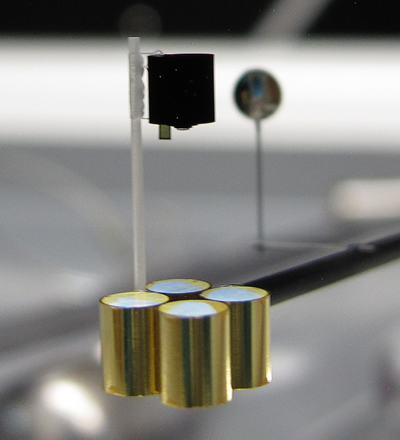 The QuadStar target used in a September 2015 Eagle experiment. for a total x-ray drive length of 60 ns. The multi-hohlraum array simulates a bright, sustained stellar source, and the NIF Eagle science package mocks up a radiatively-driven, star-forming cloud of molecular hydrogen that mimics the cluster of massive stars illuminating the Eagle Nebula.
The QuadStar target used in a September 2015 Eagle experiment. for a total x-ray drive length of 60 ns. The multi-hohlraum array simulates a bright, sustained stellar source, and the NIF Eagle science package mocks up a radiatively-driven, star-forming cloud of molecular hydrogen that mimics the cluster of massive stars illuminating the Eagle Nebula.
These are just a few of the roughly 430 targets manufactured for NIF from September 2014 to October 2015—at least 190 of which had unique fabrication requirements. “Each target has been carefully designed by teams of scientists and engineers, manufactured to extraordinary tolerances by talented technicians, assembled in clean rooms rivaling those in semiconductor plants, and inspected with microscopes and other fine-scale tools,” Wisoff said. “We depend on a team of highly skilled engineers, scientists, machinists, and technicians to develop the means to fabricate and assemble them into exquisite, minuscule objects.”
To help meet an ambitious production goal of nearly 500 targets for Fiscal Year 2016—needed to keep up with NIF’s ever-increasing shot rate (see “Target Fabrication Steps Up to the Challenges”)—engineers have established faster fabrication and assembly methods, including modular and batch processing to speed deliveries and reduce nonuniformities, and installed several new target-assembly robots in the Target Fabrication Facility.
 Engineers complete the assembly and programming of new versions of the universal robotic target assembly (RTA) robots developed to help speed the production of NIF targets. The new RTAs will work together to perform assembly steps including insertion of the hohlraum into the target shell (also known as the thermal mechanical package) and other fabrication tasks. The robot on the left, called “Viper,” moves the assembly station’s main stage for loading and unloading the targets, and the one on the right, dubbed “Cobra,” performs the fabrication steps. Credit: James Pryatel
Engineers complete the assembly and programming of new versions of the universal robotic target assembly (RTA) robots developed to help speed the production of NIF targets. The new RTAs will work together to perform assembly steps including insertion of the hohlraum into the target shell (also known as the thermal mechanical package) and other fabrication tasks. The robot on the left, called “Viper,” moves the assembly station’s main stage for loading and unloading the targets, and the one on the right, dubbed “Cobra,” performs the fabrication steps. Credit: James Pryatel Components for NIF targets are produced by LLNL, General Atomics of San Diego, and Schafer Corporation of Livermore. Experts from the three institutions make up the assembly and inspection teams, and construction of the final targets is conducted at LLNL.
For more information on the types, requirements, and fabrication challenges of NIF targets, see “A Growing Family of Targets for the National Ignition Facility,” Science & Technology Review, January/February 2016. Here is a video preview:
For a comprehensive review of the kinds of fundamental science experiments that have been enabled by NIF and other high-power lasers, pulsed-power facilities, and next-generation light sources, see “From microjoules to megajoules and kilobars to gigabars: Probing matter at extreme states of deformation,” Physics of Plasmas, Sept. 17, 2015.



